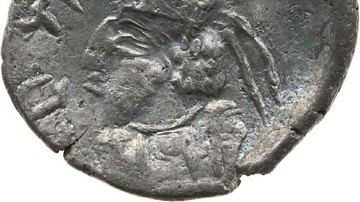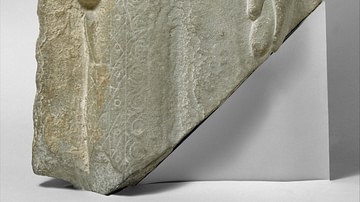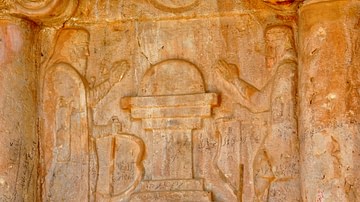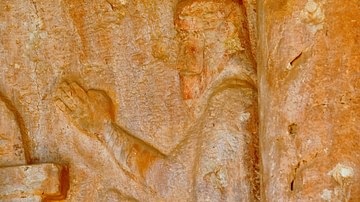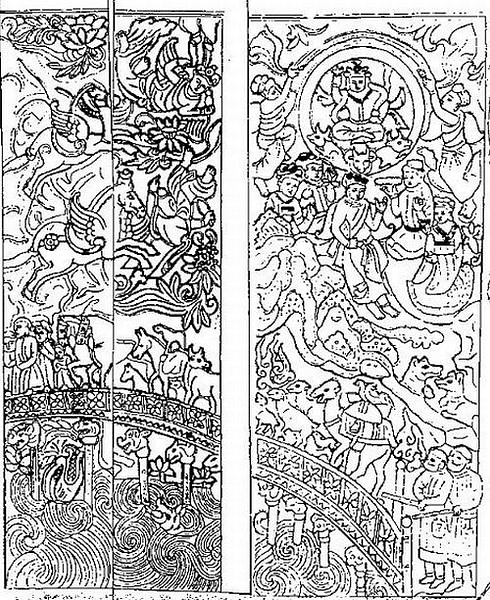
The Chinvat Bridge is the span between the world of the living and the afterlife in the ancient Persian religion of Zoroastrianism. It is also known as Cinvat Bridge, Cinvad Bridge, and Chinvato Peretav. Every soul, after death, was thought destined to cross the Chinvat Bridge where it would be judged and assigned a place in the afterlife.
Justified souls were welcomed to paradise in one of the four levels of the House of Song, condemned souls were dropped into one of the four hells of the House of Lies. Those souls whose good and bad deeds were equal were assigned to a place in between these two known as Hamistakan, an early vision of the Catholic purgatory, where they would remain until the end of time and the day of resurrection.
After Zoroastrianism was suppressed by the Muslim Arab invaders in the 7th century CE, the concept of the bridge survived and was later incorporated into the Muslim vision of the afterlife in the Hadiths where it is known as As-Sirat. Belief in the reality of As-Sirat varies among Muslims in the present day, and the validity of the ancient Persian concept, reworked by Muslim theologians, continues to be debated.
Early Religion & Development
The Early Iranian Religion was polytheistic with the deity Ahura Mazda as king of a pantheon of gods who guided and protected humanity against the forces of evil led by Angra Mainyu, the central dark spirit. At this time, the crossing between life and death was seen as a river the soul crossed on a ferry and this event was known as the Crossing of the Separator when good souls – those who had followed the light of the gods – were separated from condemned souls who had believed and followed the lies of darkness.
At some point between c. 1500-1000 BCE, the prophet Zoroaster received a vision from Ahura Mazda via a being of light, Vohu Manah (“good purpose”) enlightening him to the truth of the divine: there was only one true god – Ahura Mazda – and all the others people were worshipping were simply manifestations of the singular divine entity.
Zoroastrianism's central tenet was (and is) Good Thoughts, Good Words, Good Deeds as expressions of one's faith in the all-good Ahura Mazda, and those who adhered to this belief and practiced it would find paradise after death. At this point, it seems, the concept of the dark river which divided the world of the living from the afterlife, and the ferry the soul needed to board to cross it, was replaced by the Chinvat Bridge.
Death & the Chinvat Bridge
All that is known of the Early Iranian Religion comes from texts written long after it was replaced by Zoroastrianism and so it is difficult to tell which elements of the crossing from life to death were aspects of the early religion and which were later developments. It seems, however, that the Zoroastrianism – like many other faiths – borrowed from the older religious system.
At death, the soul lingered by the body for three days while the gods worked out the balance between one's good and bad deeds. While the gods were at their task, the funerary rituals took place and, among these, was the sagdid (“glance of the dog”) in which a dog – preferably a four-eyed dog (one with a spot above each eye) was brought into the presence of the corpse three times to scare away evil spirits (and, on a practical level, to make sure the person was dead and not simply in a coma). If the dog shied away at any time, it was interpreted to mean there were still evil spirits present (especially the demon Nasu who corrupted dead bodies) and the dog would be led in again up to nine times until its willingness to approach the corpse was interpreted to mean all evil spirits had been scared away.
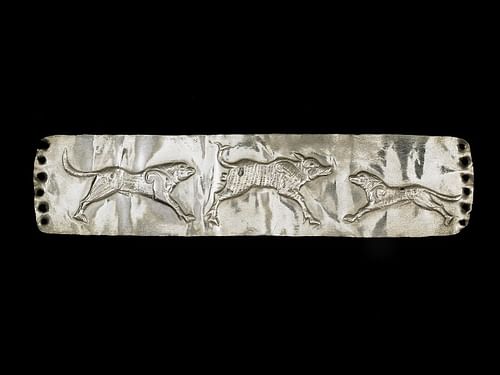
On the fourth day (or late on the third day), the soul left its body behind and traveled to the Chinvat Bridge where it was united with its higher self and became whole. Two dogs guarded the bridge who would welcome the good soul and rebuke the bad. The soul was then met by the Holy Maiden, Daena, who represented one's conscience. If one had lived a good life, Daena was a beautiful maiden; if one had followed the lies of darkness, she was an ugly hag. Daena was accompanied by the angel Suroosh who guarded the soul against attacks by demons (such as Aesma Daeva, Asto Vidatu, Vizaresha) who sought to drag it off the bridge into hell. The condemned soul is easily caught in the lasso of the demons and taken but the justified soul receives a vision of Daena and its future in paradise:
Then there comes before it on the way the form of a cow, fat and full of milk, from which happiness and sweetness come to the soul.
Secondly, there comes before it the form of a maiden, a beautiful form in white raiment and fifteen years of age [the ideal age for men or women], who is fair from every side, and at whom the soul is pleased.
Thirdly, there comes the form of a garden full of fresh fruits, full of water, full of dried fruits, and full of fertility, from which come joyous and happy thoughts to the soul. (Bundahisn 30: 4-5)
As Daena comforted the soul, and Suroosh guided and protected it, the bridge itself would expand and become easy to cross for the justified soul, but for the condemned, it would narrow to the breadth of a hair and become quite difficult to traverse. The Bundahisn continues:
There is a sharp edge [to the bridge] which stands like a sword…and hell is below the bridge. Then the soul is carried to where stands the sharp edge. Then, if it be righteous, the sharp edge presents its broad side…if the soul be wicked, that sharp edge continues to stand edgewise and does not give passage. With three steps which the soul takes forward – which are evil thoughts, evil words, and evil deeds that it has performed – it is cut down from the head of the bridge and falls headlong into hell. (Bundahisn 30: 9-13)
For those not completely evil, at the end of the bridge stood the angel Rashnu, judge of the dead and, in some versions, the god Mithra (who presided over covenants and contracts, among other responsibilities) and these two would be joined by Suroosh. The verdict on the soul's life would be read and that soul would then go on to either paradise in the House of Song, a purgatory known as Hamistakan, or the hell of the House of Lies.
Description of the Bridge
The Chinvat Bridge is most fully described in Fargard (chapter) 19 of the Vendidad, a later Zoroastrian text which concerns itself with customs and beliefs of the religion. Fargard 19:27-31 reads:
27. O Maker of the material world, thou Holy One! Where are the rewards given? Where does the rewarding take place? Where is the rewarding fulfilled? Where to do men come to take the reward that, during their life in the material world, they have won for their souls?
28. Ahura Mazda answered: "When the man is dead, when his time is over, then the wicked, evil-doing Daevas cut off his eyesight. On the third night, when the dawn appears and brightens up, when Mithra, the god with beautiful weapons, reaches the all-happy mountains, and the sun is rising"
29. Then the fiend, named Vizaresha, O Spitama Zarathushtra, carries off in bonds the souls of the wicked Daeva-worshippers who live in sin. The soul enters the way made by Time and opens both to the wicked and to the righteous. At the head of the Chinwad bridge, the holy bridge made by Mazda, they ask for their spirits and souls the reward for the worldly goods which they gave away here below.
30. Then comes the beautiful, well-shapen, strong and well-formed maid, with the dogs at her sides, one who can distinguish, who has many children, happy, and of high understanding. She makes the soul of the righteous one go up above the Hara Berezaiti; above the Chinwad bridge she places it in the presence of the heavenly gods themselves.
31. Up rises Vohu Manah from his golden seat; Vohu Manah exclaims: "How hast thou come to us, thou Holy One, from that decaying world unto this undecaying one?"
In this vision of the bridge, Vohu Manah serves the same basic purpose as the much later vision of St. Peter as keeper of the Gates of Heaven. The passage cited begins with the prophet Zoroaster (Zarathushtra) asking Ahura Mazda where, after death, are rewards given (and, presumably, punishments received) once the soul has left the body. Ahura Mazda answers with the description of the Chinvat Bridge. Hara Berezaiti, mentioned toward the end of the passage, was the holy mountain which rose on the far side of the bridge. Scholar A. T. Olmstead provides an explanation of how the bridge operated:
One's own conscience, whether of Righteous or Liar, will determine his future award. With Zoroaster as associate judge, Ahura Mazda himself will, through his counselor Righteousness, separate the wise from the unwise. Afterward, Zoroaster will guide those he has taught to invoke Mazda across Chinvato Peretav the Bridge of the Separator. Those who wisely choose will proceed to the House of Song, the Abode of Good Thought, the Kingdom of Good Thought, the Glorious Heritage of Good Thought, to which one travels by the sciences of the Saviors to pass to their reward. There shall they behold the throne of the mightiest Ahura and the Obedience of Mazda, the felicity that is with the heavenly lights. But the foolish shall go to the House of the Lie, the House of Worst Thought, the home of the daevas, the Worst Existence. Their evil conscience shall bring them torment at the Judgment of the Bridge and lead them to long future ages of misery, darkness, foul food, and cries of woe. (101)
The Chinvat Bridge, then, was the passage to and judgment for the afterlife, and it was one's own recognition of a good or bad conscience – as reflected in the guardian dogs, Daena, and the bridge itself – which made Rashnu's verdict on one's life clearly just and acceptable. The soul itself would understand why the verdict had been given and would accept it before going toward whatever destination had been decided.
The Afterlife
Once judgment was given by Rashnu, the soul went on to its afterlife home. Paradise ascended upward from the bridge through four levels while Hell descended down to the darkest depths. These levels were, from the highest to the lowest:
- Heaven of Eternal Light
- Heaven of Good Deeds
- Heaven of Good Words
- Heaven of Good Thoughts
- Chinvat Bridge
- Hell of Evil Thoughts
- Hell of Evil Words
- Hell of Evil Deeds
- Hell of Eternal Darkness
As noted, Zoroastrianism emphasized the importance of the precepts of Good Thoughts, Good Words, Good Deeds, expressed by caring for other people and showing consideration and kindness as a reflection of the love of Ahura Mazda. One's afterlife home, therefore, was decided based on how closely one had expressed this model of behavior in adhering to the precepts of Ahura Mazda and rejecting the lies of Angra Mainyu.
Somewhere between the Hell of Evil Thoughts and the Heaven of Good Thoughts, presumably around the base of Hara Berezaiti, was the purgatory of Hamistakan for souls whose good and bad thoughts, words, and deeds balanced out. Here one was rewarded for any good and punished for any bad but these rewards and punishments targeted specific parts of the soul, not the entirety of it. If, for example, one had regularly kicked a dog, one's foot would be aflame in the same way one's tongue would if one had habitually spoken angry words.
Even so, no matter how badly one had gone astray in life – nor how well one had behaved – all souls would finally be welcomed into the presence of Ahura Mazda who was so benevolent he could not allow any of his creations to suffer eternally. The souls in even the darkest and deepest level of the House of Lies would be redeemed one day when the final messiah arrived – the Saoshyant (“One Who Brings Benefit”) who would usher in the End of Time (Frashokereti) and bring redemption, purification of all souls, resurrection of the physical bodies, and reunion with Ahura Mazda in paradise where all would be reunited in an eternal bliss, the old world would pass away, and the evil of Angra Mainyu would be utterly destroyed.
Conclusion
This vision was preserved in writing by the Sassanians long after it was first developed. Early Iranian Religion and later Zoroastrianism were both oral faiths with no written scripture. The sacred words were memorized, recited at services, and passed down to the next generation until they were committed to writing during the Sassanian Period (224-651 CE). The Sassanian rulers, starting with Ardashir I (r. 224-240 CE), collected these works by inviting priests who knew the scriptures in Avestan (the ancient language of Iran) to their courts to recite them and have them translated into written form. In order to do this, a whole new script had to be invented which would preserve the phonetics of spoken Avestan. This script was developed from Aramaic but carefully reworked to render the meaning and pronunciation of the ancient language clearly.
The written record of Avestan continued under Ardashir I's son and successor Shapur I (r. 240-270 CE) but was first realized during the reign of Shapur II (309-379 CE) and fully completed under Kosrau I (r. 531-579 CE). Sassanid monarchs after Kosrau I continued these efforts, refining and further defining the ancient tenets of the faith.
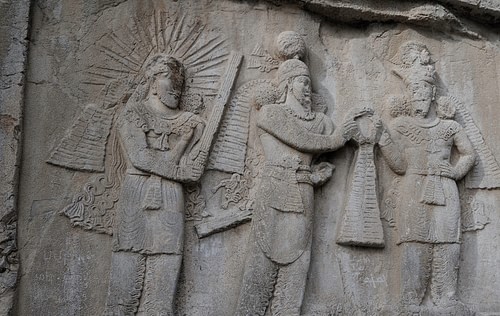
The Sassanian Empire fell to the invading Muslim Arabs in 651 CE and, afterwards, Zoroastrianism was suppressed, the libraries were burned, and the altars destroyed. Although much was irrevocably lost, a number of written works survived alongside a revival of the oral tradition and would influence not only Islam but also Christianity and Judaism. The concept of a bridge to the afterlife, common in a number of world cultures, would find its way into Islam through the specifics of the Persian vision.
The As-Sirat Bridge, as described in the Muslim religious commentary Hadith Bukhari (among others) is a direct reflection of the Chinvat Bridge. Although Muslim clerics and secular scholars may continue to debate the Persian influence of the Chinvat Bridge on As-Sirat, the similarities are too distinct to ignore. As-Sirat Bridge also narrows for the unrighteous and widens for the just, and it is also regarded as the final place of judgment before the soul goes to either paradise or hell. Further, the Islamic bridge also spans the abyss over hell only, in the latter vision, crossing the span is more difficult due to barbs and hooks and other contrivances which hamper the soul while the flames of hell literally lick at one's feet.
In the Islamic version of the bridge, only faithful Muslims will cross while, in the original Persian vision, it was the destination of every mortal being. In the later monotheistic faiths which were influenced by the Persians, the soul – whether judged on a bridge or before a throne of gold – was sent to an eternal destination while, in the Persian vision, one only resided in one's afterlife domain for a period before finally being redeemed and called to reunion with one's creator. This aspect of the Early Iranian and later Zoroastrian systems commends the faiths as among the most benevolent visions of the afterlife ever imagined.

